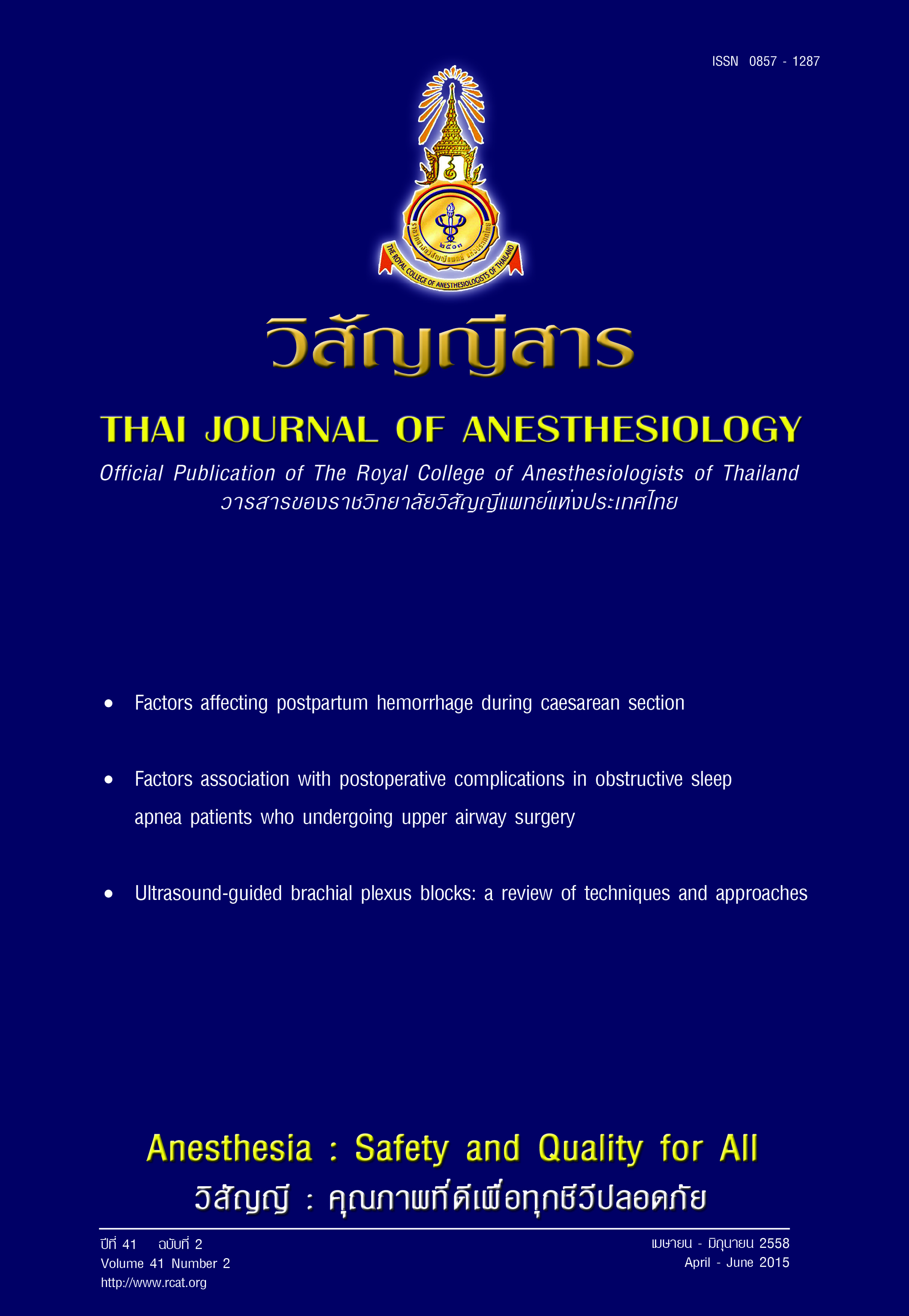Hemodynamic effects of combined lumbar plexus and sciatic nerve block compared with spinal anesthesia in patients undergoing total knee arthroplasty and knee arthroscopy
Main Article Content
Abstract
Background: Spinal anesthesia is an effective anesthetic technique for knee surgery. The patients, however, occasionally have a hemodynamic instability. Peripheral nerve block might have a role in reducing these complications. The study compared the hemodynamic effects after the combined lumbar plexus and sciatic nerve block technique and spinal anesthesia.
Methods: Fifty ASA classification I-II patients aged between 18-70 years who underwent total knee arthroplasty or knee arthroscopy were divided equally into two groups. The patients in the SA group were operated under spinal anesthesia using 3 ml of 0.5% hyperbaric bupivacaine. The other group, the LPSB group, was anesthetized with combined lumbar plexus block and sciatic nerve block using mixed 15 ml of 2% lidocaine with adrenaline and 15 ml of 0.5% levobupivacaine for the lumbar plexus block and mixed 10 ml of 2% lidocaine and 10 ml of 0.5% levobupivacaine for the sciatic nerve block.
Results: Pre - anesthetic blood pressure and heart rate were not different in both groups. The systolic blood pressure of the SA group was significantly less than that of the LPSB group at 10 minutes (109.52 ± 14.16 mmHg for the SA group and 124.04 ± 15.17 mmHg for the LPSB group; p-value = 0.001) and remained constant between 10-20 minutes after the block. The mean of heart rate of the LPSB group slightly rose while the heart rate of the SA group was roughly constant.
Conclusions: The combined lumbar plexus and sciatic nerve block technique provides adequate anesthesia for knee surgery. The hemodynamic effects on LPSB group are more stable than those on SA group.
ผลต่อระบบไหลเวียนเลือดจากการสกัดกั้นเส้นประสาท Lumbar Plexus ร่วมกับ Sciatic Nerve เปรียบเทียบกับการสกัดกั้นเส้นประสาทส่วนกลาง Spinal Anesthesia ในผู้ป่วยที่มารับการผ่าตัดเปลี่ยนข้อเข่าและ การผ่าตัดข้อเข่าโดยวิธีส่องกล้อง
บทนำ: การทำspinal anesthesia เป็นเทคนิคที่มีประสิทธิภาพสำหรับการผ่าตัดข้อเข่า แต่อาจมีผลต่อระบบไหลเวียนเลือดได้มาก การสกัดกั้นเส้นประสาทส่วนปลายน่าจะสามารถลดภาวะแทรกซ้อนดังกล่าวได้ การศึกษานี้จึงเปรียบเทียบผลต่อระบบไหลเวียนเลือดจากการสกัดกั้นเส้นประสาท lumbar plexus ร่วมกับ sciatic nerve กับ spinal anesthesia
วิธีการศึกษา: ผู้ป่วยอายุ 18-70 ปี ASA classification I-II ที่รับการผ่าตัดเปลี่ยนข้อเข่าหรือการผ่าตัดข้อเข่าโดยวิธีส่องกล้อง จำนวน 50 คน แบ่งเป็นกลุ่มละ 25 คน กลุ่มแรกได้รับการระงับความรู้สึกด้วยวิธี spinal anesthesia (SA) โดยใช้ยา 0.5% hyperbaric bupivacaine 3 ml กลุ่มที่ 2 (กลุ่ม LPSB) ได้รับการสกัดกั้นเส้นประสาท lumbar plexus โดยใช้ยา 2% lidocaine with adrenaline 15 ml ที่ผสมกับ 0.5% levobupivacaine 15 ml ร่วมกับ sciatic nerve block โดยใช้ยา 2% lidocaine 10 ml ที่ผสมกับ 0.5% levobupivacaine 10 ml
ผลการศึกษา: ผู้ป่วยทั้ง 2 กลุ่มมีความดันเลือดและอัตราการเต้นของหัวใจก่อนการระงับความรู้สึกไม่แตกต่างกัน หลังจากการ block ผู้ป่วยกลุ่ม SA มีความดันเลือดเฉลี่ยลดลงมากกว่ากลุ่ม LPSB อย่างมีนัยสำคัญตั้งแต่นาทีที่ 10 (109.52 ± 14.16 mmHg ในกลุ่ม SA และ 124.04 ± 15.17 mmHg ในกลุ่ม LPSB, p-value = 0.001) โดยพบอัตราการเต้นของหัวใจเฉลี่ยที่เพิ่มขึ้นในกลุ่ม LPSB และอัตราการเต้นของหัวใจเฉลี่ยค่อนข้างคงที่ในกลุ่ม SA
สรุป: การสกัดกั้นเส้นประสาท lumbar plexus ร่วมกับ sciatic nerve เป็นเทคนิคการระงับความรู้สึกที่ครอบคลุมการผ่าตัดบริเวณข้อเข่าได้ และสามารถควบคุมความดันเลือดให้คงที่ได้ดีกว่าการทำspinal anesthesia

